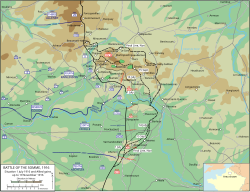
Back Bataille des hauteurs de l'Ancre French Pertempuran Ancre Heights ID Battaglia delle colline dell'Ancre Italian Битва за висоти Анкре Ukrainian
| Battle of the Ancre Heights | |||||||
|---|---|---|---|---|---|---|---|
| Part of the Battle of the Somme of the First World War | |||||||
 Battle of the Somme 1 July – 18 November 1916 | |||||||
| |||||||
| Belligerents | |||||||
|
|
| ||||||
| Commanders and leaders | |||||||
|
Joseph Joffre Douglas Haig Ferdinand Foch Hubert Gough |
Erich Ludendorff Kronprinz Rupprecht Max von Gallwitz Fritz von Below | ||||||
| Units involved | |||||||
| Reserve Army/Fifth Army | 1st Army | ||||||
| Strength | |||||||
| 6 divisions | |||||||
The Battle of the Ancre Heights (1 October – 11 November 1916), is the name given to the continuation of British attacks after the Battle of Thiepval Ridge from 26 to 28 September during the Battle of the Somme. The battle was conducted by the Reserve Army (renamed Fifth Army on 29 October) from Courcelette near the Albert–Bapaume road, west to Thiepval on Bazentin Ridge.[a] British possession of the heights would deprive the German 1st Army of observation towards Albert to the south-west and give the British observation north over the Ancre valley to the German positions around Beaumont-Hamel, Serre and Beaucourt. The Reserve Army conducted large attacks on 1, 8, 21, 25 October and from 10 to 11 November.
Many smaller attacks were made in the intervening periods, amid interruptions caused by frequent heavy rain, which turned the ground and roads into rivers of mud and grounded aircraft. German forces in footholds on the ridge, at the east end of Staufen Riegel (Regina Trench) and in the remaining parts of Schwaben-Feste (Schwaben Redoubt) to the north and Stuff Redoubt (Staufen-Feste) north-east of Thiepval, fought a costly defensive battle with numerous counter-attacks and attacks, which delayed the British capture of the heights for more than a month.
Stuff Redoubt fell on 9 October and the last German position in Schwaben Redoubt fell on 14 October, exposing the positions of the 28th Reserve Division in the Ancre valley to British ground observation. A German retreat from the salient that had formed around St. Pierre Divion and Beaumont Hamel either side of the Ancre, was considered by Generalquartiermeister Erich Ludendorff and the new army group commander Field Marshal Rupprecht, Crown Prince of Bavaria and rejected, due to the lack of better defensive positions further back, in favour of counter-attacks desired by General Fritz von Below the 1st Army commander. General Max von Gallwitz the 2nd Army commander, noted in early October that so many of his units had been moved to the 1st Army north of the Somme, that he had only one fresh regiment in reserve.
The German counter-attacks were costly failures and by 21 October, the British had managed to advance 500 yd (460 m) and take all but the last German foothold in the eastern part of Staufen Riegel (Regina Trench). A French offensive during the Battle of Verdun on 24 October, forced the Germans to suspend the movement of troops to the Somme front. From 29 October – 9 November, British attacks were postponed due to more poor weather, before the capture of 1,000 yd (910 m) of the eastern end of Regina Trench by the 4th Canadian Division on 11 November. Fifth Army operations resumed in the Battle of the Ancre (13–18 November).
Cite error: There are <ref group=lower-alpha> tags or {{efn}} templates on this page, but the references will not show without a {{reflist|group=lower-alpha}} template or {{notelist}} template (see the help page).
© MMXXIII Rich X Search. We shall prevail. All rights reserved. Rich X Search